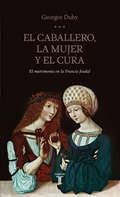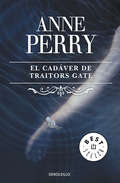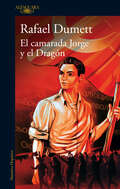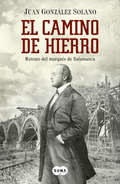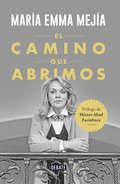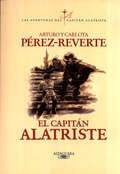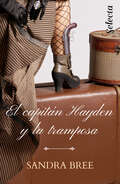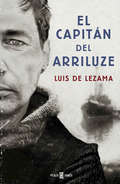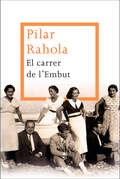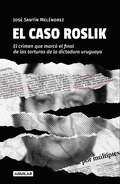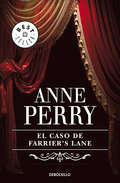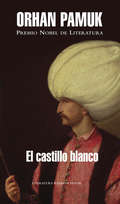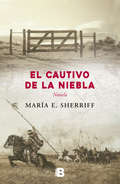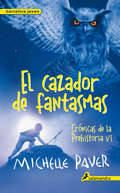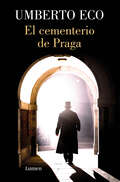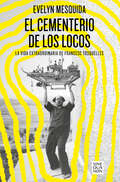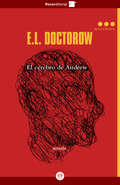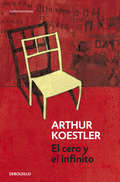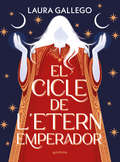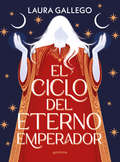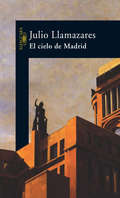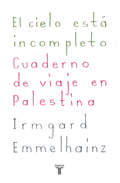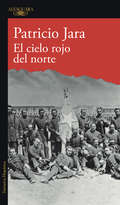- Table View
- List View
El caballero, la mujer y el cura: El matrimonio en la Francia feudal (Humanidades/taurus Ser. #Vol. 207)
by Georges Duby¿Es el matrimonio una institución inmutable? ¿Qué influencia tuvieron en su conformación la Iglesia y la sociedad feudal? En esta obra ya clásica, el gran historiador francés Georges Duby demuestra una vez más que la historia no sólo se escribe desde los sucesos relevantes y espectaculares como las guerras, las conquistas o los descubrimientos, sino también desde el estudio de lo cotidiano. El caballero, la mujer y el cura aborda la conformación del sistema matrimonial del Occidente cristiano y cómo la unión conyugal se convierte en reflejo del equilibrio de poderes de la sociedad feudal: la relación entre señores y vasallos reproducida en la relación marido-mujer y el papel ordenador, en lo moral y en lo jurídico, de la Iglesia. Pero la unión conyugal controlada por el clero no logra imponerse más que tras una larga lucha entre los señores feudales y la Iglesia que culmina en el siglo xii. Ésta es también la historia de ese conflicto, que desemboca en un nuevo equilibrio y el surgimiento de una renovada moral del matrimonio.
El cadáver de Traitors Gate (Inspector Thomas Pitt #Volumen 15)
by Anne PerryEl inspector Pitt y su perspicaz esposa Charlotte deben investigar varios asesinatos en el marco de las relaciones burocráticas sobre la colonización del continente africano. La decimoquinta novela de la serie del inspector Pitt En pleno reparto de las preciadas riquezas del continente africano, una serie de extraños asesinatos ponen al inspector Pitt y a su infatigable esposa Charlotte sobre la pista del misterioso Círculo Interior, del que se está filtrando información para una potencia enemiga. Un carismático ministro, distintos personajes que están a favor o en contra de la explotación de África, una esposa crítica con las ideas colonialistas de su marido... En conjunto, una emocionante trama que hará las delicias de los seguidores del entrañable e incansable detective del Londres victoriano. La crítica ha dicho...«La autora recrea como nadie el ambiente de corrupción e hipocresía de la Inglaterra de finales del siglo XIX.»Publishers Weekly
El camarada Jorge y el Dragón
by Rafael Dumett"A nadie le importa cómo entras a la Historia, Shito. Si por la puerta de adelante, la de atrás o la del costado. Eso sí, una vez que ya estás adentro, nadie te saca" Deportado cinco veces por cuatro presidentes peruanos, sospechoso de haber estado involucrado en tres golpes de estado en el Perú y uno en el extranjero, Eudocio Ravines, figura ácida y rutilante en la historia latinoamericana del siglo XX, aparece por doquiera que uno escarbe, conspirando, denunciando, polemizando, escaldando y sacando de quicio. Después de una relación estrecha y dramática con Víctor Raúl Haya de la Torre y José Carlos Mariátegui, abandona sus roles de comisario político de alto nivel en la Internacional Comunista para combatir la ideología que antes defendía férreamente, y convertirse en caja de resonancia de la propaganda de la CIA. El camarada Jorge y el Dragón, el primer volumen de una saga en torno a su figura, recrea sus años infantiles y juveniles en su turbulenta Cajamarca natal, al amparo de las mujeres de la familia y de su tío, el coronel Belisario Ravines, héroe de la guerra del Pacífico y principal autoridad local de gobierno. Luego del éxito de El Espía del Inca, Rafael Dumett vuelve a sorprender con esta novela histórica de aprendizaje, en que usa magistralmente la ficción para diluirse por completo en la vida del controvertido Eudocio Ravines, pieza fundamental para calibrar los subterráneos de la historia peruana y global del siglo pasado, que ya muestran ecos imprevistos en el presente.
El camino de hierro: Retrato del marqués de Salamanca
by Juan González SolanoEl camino de hierro es la historia del marqués de Salamanca, un relato sobre la profunda transformación de España y Europa a mediados del siglo XIX, una crónica sobre la construcción del Madrid moderno y un ejemplo de la feroz lucha de un hombre por sus ideales.«En esta tierra, el Estado, la Nación, la Patria, llámelo como quiera, no ha hecho gran cosa por sus ciudadanos, más bien al contrario. Esa es la percepción de quienes habitamos esta península seca y desgraciada. La prueba es que no sentimos ningún afecto por el Estado, del que solo esperamos disgustos». Igual que un paisaje de férreas vías alargándose kilómetros en el horizonte, se vislumbra el éxito de José de Salamanca, quien decide apostar por el ferrocarril, un proyecto que lo convertirá en uno de los empresarios más importantes de la historia de España.José es un hombre arriesgado en los negocios y en los sentimientos, pero mucho más afortunado en lo primero que en lo segundo. Después de haber perdido a su gran amor, Mariana Pineda, Salamanca se mueve entre la familia y su intensa vida galante, al tiempo que pone en marcha su gran empresa: la construcción de las principales líneas de ferrocarril de España, en especial la de Madrid a Aranjuez, que harán posible la modernización industrial y que, poco después, él mismo tendrá que usar para huir tras la revolución de Vicálvaro contra Isabel II. Su astucia y su voluntad lo llevarán a triunfar en Europa y América, a ser nombrado marqués de Salamanca y conde de los Llanos y a disfrutar de una vida de esplendor. Sin embargo, años después, tanto la inestabilidad política como la crisis económica que asoló España harán que su suerte cambie drásticamente, a pesar de lo cual no renunciará a su último gran sueño, dando su vida y su fortuna por su causa: la construcción del barrio de Salamanca, en el corazón de Madrid.El camino de hierro es la historia del marqués de Salamanca, pero también un relato sobre la profunda transformación de España y Europa a mediados del siglo XIX, así como una crónica sobre la construcción del Madrid moderno y un ejemplo de la feroz lucha de un hombre por sus ideales. Reseña:«El retrato de un visionario marcado por la pérdida de su gran amor (...) Es la narración de un hombre de negocios que apostó por el ferrocarril y de aquella España del siglo XIX que quería transformarse».Expansión«La vida del marqués de Salamanca se entrelaza con la de los grandes protagonistas de esta época de nuestra historia: Serrano, O#Donnell, Espartero o Isabel II, entre otros, incluso Alejandro Dumas tendrá su lugar mostrándonos las múltiples y sorprendentes facetas en la vida del protagonista».Blog Me gustan los libros«El libro es una recreación de un momento crucial en la historia de España, un momento que supone la modernización del país».Leer
El camino que abrimos
by María Emma MejíaEl libro de memorias de María Emma Mejía Cuando María Emma Mejía se abrió paso en la vida política colombiana, el país transitaba por uno de los periodos más violentos de su historia. Conoció de cerca una guerra en la que perdieron la vida la periodista Diana Turbay, su amiga, y Luis Carlos Galán, su jefe político. En aquellos difíciles años, en su ciudad, Medellín, lideró el programa Arriba mi barrio, referente de inclusión social en las comunas a través del reconocimiento, la identidad y el arte, donde fue testigo del trasfondo de una sociedad dividida. En un mundo político convulso, dominado por hombres, María Emma fue una pionera. Su vida es una lección de pragmatismo, de un poder que nace de la dificultad y que crea puentes entre fuerzas antagónicas. Como ministra, canciller, embajadora, candidata, diplomática en organismos internacionales y directora en actividades filantrópicas, ha defendido la equidad social y de género y posicionado al país en el panorama mundial. A la manera de alguien que hace un alto en el camino y vuelve la vista atrás, María Emma Mejía relata su vida y presenta su versión de acontecimientos que marcaron el rumbo de Colombia y que la convirtieron en pieza clave del poder público de las últimas décadas.
El capitán Alatriste (Las aventuras del capitán Alatriste #Volumen 1)
by Arturo Pérez-ReverteAcción, historia y aventura se dan cita como un torbellino en las inolvidables páginas de esta primera novela de la serie «Las aventuras del capitán Alatriste», que comienza cuando el valeroso protagonista acepta un peligroso encargo... «No era el hombre más honesto ni el más piadoso, pero era un hombre valiente.» Con estas palabras empieza El capitán Alatriste, la historia de un soldado veterano de los tercios de Flandes que malvive como espadachín a sueldo en el Madrid del siglo XVII. Sus aventuras peligrosas y apasionantes nos sumergen sin aliento en las intrigas de una España corrupta y en decadencia, las emboscadas en callejones oscuros entre el brillo de dos aceros, las tabernas donde Francisco de Quevedo compone sonetos entre pendencias y botellas de vino, o los corrales de comedias donde las representaciones de Lope de Vega terminan a cuchilladas. Todo ello de la mano de personajes entrañables y fascinantes: el joven Íñigo Balboa, el implacable inquisidor fray Emilio Bocanegra, el peligroso asesino Gualterio Malatesta, o el diabólico secretario del rey, Luis de Alquézar. La crítica ha dicho...«Arturo Pérez-Reverte, entre cuyas obras anteriores cabe destacar La Reina del Sur, ha creado Alatriste con un afecto evidente. El autor comparte con el espadachín un indudable talento. El capitán Alatriste está escrito con brillantez y un contagioso entusiasmo hacia el género que intenta revivir...»Janet Maslin, The New York Times «[...]tenemos como resultado una novela fascinante, que agarra nada más empezar y sujeta hasta su última página. [...] la novela me ha subyugado con tanta fuerza que la vista se adelantaba al texto porque el corazón estaba en suspenso o se aceleraba a causa de los azarosos sucesos que pasaban en el papel.»Santos Sanz Villanueva, El Mundo «Digámoslo claro: nunca se agradecerálo bastante a Reverte haber hecho entrar a tantos lectores en esa literatura y esa historia cautivándolos con unas narraciones apasionantes y, por la fascinación que produce el héroe, implicándolos como coprotagonistas.»Francisco Rico «El estilo recrea la lengua del Siglo de Oro, con su léxico, modismos y frases hechas, numerosos versos e incluso algunas voces de germanía, todo ello bien integrado en un texto de suma eficacia narrativa.»Ángel Basanta «Su sabiduría narrativa, tan bien construida siempre, tan exhaustivamente detallada, documentada y estructurada, hasta el punto que, frente a todo ello, la historia real resulta endeble y a veces hasta tópica.»Rafael Conte «Al capitán Alatriste le cabe el honor de ser una de esas criaturas de ficción que han ingresado en el selecto club de los mitos literarios, aquellos personajes que gozan en el imaginario colectivo de una personalidad propia y de una vigencia intemporal. Todo un mérito, si tenemos en cuenta que a este club de élite pertenece solo otra media docena de miembros españoles, nada menos que de la influencia histórica y el prestigio cultural del Cid, la Celestina, don Juan o don Quijote.»Alberto Montaner
El capitán Hayden y la tramposa
by Sandra BreeUna novela romántica, ambientada en la época victoriana, que te hará reír y enamorarte. Año 1865. La preciosa señorita Ana Peterson necesita escapar de los horrores que la Guerra de Independencia está ocasionando. Toda su familia ha muerto a excepción de una prima suya que se encuentra al otro lado del país. Recorrer ese camino sola es muy peligroso, pero contratar a alguien que la lleve tampoco es tan fácil. Sin embargo, aunque no sea el modo más honrado de hacerlo, miente a Drew Hayden, un apuesto y gallardo capitán de la Unión que regresa a su casa en Minnesota, para que le acompañe. Para eso le hace creer que es la prometida de un colega suyo del ejército. Drew intenta ser fiel a sus principios. Es un hombre hecho y derecho, un caballero por naturaleza y educación y no va a sucumbir a los encantos de una mujer que lo desconcierta cada vez más a medida que la va conociendo. Este viaje solo puede acabar de dos maneras para el capitán y la señorita: o acaban siendo buenos amigos, o terminan odiándose a muerte cuando se descubra el engaño. Si llega a descubrirse...
El capitán Hayden y la tramposa
by Sandra BreeUna novela romántica, ambientada en la época victoriana, que te hará reír y enamorarte. Año 1865. La preciosa señorita Ana Peterson necesita escapar de los horrores que la Guerra de Independencia está ocasionando. Toda su familia ha muerto a excepción de una prima suya que se encuentra al otro lado del país. Recorrer ese camino sola es muy peligroso, pero contratar a alguien que la lleve tampoco es tan fácil. Sin embargo, aunque no sea el modo más honrado de hacerlo, miente a Drew Hayden, un apuesto y gallardo capitán de la Unión que regresa a su casa en Minnesota, para que le acompañe. Para eso le hace creer que es la prometida de un colega suyo del ejército. Drew intenta ser fiel a sus principios. Es un hombre hecho y derecho, un caballero por naturaleza y educación y no va a sucumbir a los encantos de una mujer que lo desconcierta cada vez más a medida que la va conociendo. Este viaje solo puede acabar de dos maneras para el capitán y la señorita: o acaban siendo buenos amigos, o terminan odiándose a muerte cuando se descubra el engaño. Si llega a descubrirse...
El capitán del Arriluze
by Luis LezamaConspiraciones, secretos y misterios en pleno estallido de la guerra civil española.Una historia real, épica y trágica sobre el significado de la lealtad. «Solo Luis de Lezama podía escribir esta novela, una historia personalen tiempos de guerra que me ha emocionado profundamente.»Julia Navarro Corre el verano de 1936 y la situación política en España se ha complicado en extremo en los últimos meses. En cada puerto se tejen conspiraciones de todo signo pero ninguna de ellas logra empañar la felicidad de Poli Baraño, quien acaba de cumplir su gran sueño: comprar el buque en el que ha trabajado casi toda su vida, el Arriluze. Zarpa de Valencia en los primeros días de julio con la ilusión de arribar pronto a Bilbao y así celebrar con los suyos el nacimiento de su primer nieto, al que todavía no conoce. Antes de partir es abordado por dos hombres que se identifican como agentes al servicio de la República y que le piden que lleve a cabo una misteriosa misión bajo el nombre en clave de Yerma. Solo podrá saber de qué se trata una vez se encuentre en alta mar. La travesía tendrá, además, invitados inesperados: la actriz republicana y musa de Federico García Lorca, Margarita Xirgu, y un sospechoso inspector de vapores llamado Jacobo Leguina. La sublevación militar del 18 de julio les encuentra en el Estrecho de Gibraltar, trastocando por completo los planes de todos. La situación se vuelve más delicada de día en día: cada puerto es una incógnita, la vida del pasaje corre peligro y los malos presagios se suceden en un mar de tinieblas, iluminado por los fogonazos de una guerra fratricida. «Descubrí que los barcos tienen alma. El alma es propiedadde las personas que los mandan. Navegan según el alma. Unbarco sin alma es un cuerpo vacío. Puede ser arrastrado porel viento o llevado por las corrientes hasta el naufragio.»
El carrer de l'embut
by Pilar RaholaValent-se de la tècnica del collage i alternant els punts de vista per retratar una realitat calidoscòpica, Pilar Rahola evoca un univers fascinant en el seu camí cap a l’esfondrament, i, alhora, ret també un homenatge als ideals de la República i als mestres que en van ser l’estendard. De la mà de dos personatges a punt d’embarcar cap a Cuba -en Miquel, jove de Cadaqués que hi va a fer de capatàs, i la Montserrat, filla de la burgesia barcelonina-, Pilar Rahola ens fa passejar per un extraordinari entramat de relacions -sindicalistes, polítics, artistes, pescadors...- i per alguns dels moments cabdals dels anys vint i trenta a Catalunya i a Cuba. Rahola recrea des dels anys de la dictadura de Primo de Rivera i el pistolerisme pels carrers de Barcelona fins a la proclamació de l’Estat Català per Lluís Companys a la plaça Sant Jaume, de la bomba del Liceu a l’esclat de la Guerra Civil i els Fets de maig del 1937, i també la Cuba efervescent de les plantacions de sucre, el teatre, la Macorina i l’esclavatge. I, com un món dins el món, tancat i tanmateix reflex de l’exterior, Cadaqués, un gresol on es fonen el paisatge tel·lúric i la cultura refinada, les bruixes, la vida dels pescadors i els burgesos estiuejants, la Ben Plantada, Dalí, el gran pedagog Lluís Tasis, Duchamp... Un gresol, malgrat tot, que amb la Guerra Civil no podrà escapar d’esberlar-se i que el trastornin els vaivens del món i de la història.
El caso Roslik: El crimen que marcó el final de las torturas de la dictadura uruguaya
by José Santin MeléndrezEl crimen que marcó el final de las torturas de la dictadura uruguaya. El 16 de abril de 1984, mientras en Uruguay se negociaba el regreso a la democracia luego de once años de dictadura, el médico uruguayo Vladimir Roslik, oriundo de la comunidad rusa de San Javier, murió como consecuencia de las torturas que un grupo de militares le infligió durante su detención en el cuartel n.° 9 de Río Negro. Su muerte fue motivo de alarma y conmoción en una sociedad que anhelaba el fin de una etapa terrible de la historia nacional. Este libro recorre los episodios más relevantes del controversial «Caso Roslik», a través de entrevistas actuales, relevamiento de notas publicadas por el semanario Jaque días después del homicidio y transcripciones de documentos oficiales. Un crimen que evidenció el debilitamiento del poder militar, sus tensiones internas, y marcó el fin de las torturas de las Fuerzas Armadas en el país.
El caso de Farrier's Lane (Inspector Thomas Pitt #Volumen 13)
by Anne PerryUna emocionante historia de intriga que nos sumerge de lleno en el Londres de la época victoriana y el ingenioso método detectivesco del inspector Thomas Pitt. La decimotercera novela de la serie del inspector Pitt El juez Stafford ha sido envenenado con opio y el inspector Pitt es el encargado de investigar este crimen, asunto que cada vez se va haciendo más y más complejo, pues tropezará con una serie de tramas sentimentales entre sus amigos y conocidos, con las contradicciones de la justicia, con el antisemitismo latente en la sociedad victoriana y con las peculiaridades del mundo teatral. Y a medida que sigue investigando, el inspector Pitt irá recomponiendo una triste historia familiar. La crítica ha dicho... «Lectura obligada para todo adicto al suspense.» El Periódico
El castillo blanco
by Orhan PamukEsta deslumbrante novela, con la que el Premio Nobel de Literatura obtuvo un gran reconocimiento internacional, ofrece una sinuosa reflexión sobre la identidad y las relaciones entre oriente y occidente. Un joven científico indiano es capturado por piratas cuando viaja de Venecia a Nápoles. Poco después es vendido como esclavo a un sabio turco deseoso de conocer los avances científicos de Occidente. Ambientada en la Turquía del siglo XVII, El castillo blanco cuenta la extraordinaria historia de estos dos hombres, que curiosamente guardan un gran parecido físico. Una fascinante exploración de la identidad, del fatídico pulso entre tradición y modernidad, y del destino del intelectual a través de la relación que surge entre ambos personajes. Reseñas:«Una novela brillante, digna de un narrador único, excepcional.»John Updike «Una nueva estrella nace en Oriente: Orhan Pamuk, un escritor turco. El castillo blanco es una muestra de su gran talento, con la que se ha ganado el mérito de ser comparado con Calvino y Borges; la sombra de ambos planea sobre la novela a modo de ángeles de la guarda.»Jay Parini, The New York Times
El cautivo de la niebla
by María SherriffBasada en una historia real, El cautivo de la niebla nos presenta a Daniel Gilmour -también conocido como Nicolás González-, un personaje entrañable, con un destino errante y azaroso. Vivió entre gauchos e indios, a merced de las levas, en la Guerra del Paraguay y en lucha contra los malones de la pampa argentina. Un niño de padres escoceses fue raptado de su hogar en el año 1852 en la zona del Tuyú, entonces la frontera sur de la provincia de Buenos Aires. Su madre, que lo buscó durante más de treinta años, se maldecía por haber seguido a su marido a estas tierras inacabables, desiertos de pasto y arena, con lagunas por todas partes. ¿Acaso se podía salir a buscar a un hijo perdido? ¿Hacia dónde había que marchar, qué norte, qué señales seguir? Desde pequeña, María E. Sherriff tuvo la necesidad de ahondar en el misterio de la vida de Daniel Gilmour, antepasado suyo, hermano de su bisabuela. Los cuentos de tías y abuelas la sedujeron desde entonces, y fue su anhelo, muchas veces postergado, el de investigar a fondo para luego escribir su propia versión de la historia, El cautivo de la niebla. Con una prosa cuidada, siempre fresca y espontánea, también indaga, con hondura, en el conflicto de la identidad: ¿quién era Daniel en realidad? ¿Qué buscaba? ¿Qué sentía?
El cazador de fantasmas: Crónicas de la prehistoria VI (Crónicas de la Prehistoria #Volumen 6)
by Michelle PaverSexta y última entrega de la apasionante serie «Crónicas de la Prehistoria», que ha sido incluida por The Times entre los cien mejores libros de la década. Una historia sobre la supervivencia y el poder de la amistad en la que Torak llegará al final de su viaje. La Noche de las Almas está cada vez más cerca. Eostra, la hechicera de los Búhos Reales, mantiene aterrorizados a los clanes en su intento de dominar el mundo de los vivos y de los muertos. Así, Torak debe abandonar el Bosque para buscar la guarida de la Devoradora de Almas en la Montaña de los Fantasmas. En compañía de Renn, emprende un peligroso viaje a través de parajes helados, durante el cual ambos descubrirán la fuerza de su vínculo y hallarán nuevas alianzas que los impulsarán a seguir adelante. Lobo, su fiel hermano de camada, tendrá que superar el dolor más atroz y evitar que la malvada hechicera le arrebate aquello que más quiere.
El cementerio de Praga
by Umberto EcoUna extraordinaria novela que abarca desde los inicios del siglo XIX hasta los primeros años del siglo XX. Marzo, 1897. París. Un hombre de sesenta y siete años escribe sentado a una mesa, en una habitación abarrotada de muebles: he aquí al capitán Simonini, un piamontés afincado en la capital francesa, que desde muy joven se dedicó al noble arte de crear documentos falsos.Hombre de pocas palabras, misógino y glotón impenitente, el capitán se inspira en los folletines de Dumas y Sue para dar fe de complots inexistentes, fomentar intrigas o difamar a las grandes figuras de la política europea. Sin escrúpulos, Simonini trabaja al servicio del mejor postor: si antes fue el gobierno italiano quien pagó por sus imposturas, luego llegaron los encargos de Francia y Prusia, e incluso Hitler acabaría aprovechándose de sus malvados oficios.A través de las experiencias únicas de Simonini, la intriga de la Europa del siglo XIX desfila por las páginas de esta cautivadora novela de Umberto Eco, quien, treinta años tras la publicación de El nombre de la rosa, regresa a la ficción y nos muestra que en la literatura como en la vida, nada es lo que parece y nadie es quien dice ser.
El cementerio de Praga
by Umberto EcoTreinta años después de publicar El nombre de la rosa, Umberto Umberto Eco vuelve para mostrarnos que, en la literatura y en la vida, nada es lo que parece y nadie es quien realmente dice ser. París, 1897. Un hombre escribe sentado a una mesa en una habitación abarrotada de muebles: he aquí al capitán Simonini, un piamontés afincado en la capital francesa, que desde muy joven se dedica al noble arte de crear documentos falsos. Hombre de pocas palabras, misógino y glotón impenitente, el capitán se inspira en los folletines de Dumas y Sue para dar fe de complots inexistentes, fomentar intrigas o difamar a las grandes figuras de la política europea. Caballero sin escrúpulos, Simonini trabaja al servicio del mejor postor: si antes fue el gobierno italiano quien pagó por sus imposturas, luego llegaron los encargos de Francia y Prusia, e incluso Hitler acabaría aprovechándose de sus malvados oficios... Reseñas:«Su mejor novela desde El nombre de la rosa.»Justo Navarro, Babelia, El País «Más irónico que nunca y sumamente divertido.» Matías Néspolo, Tendencias, El Mundo «Eco ha gestado una obra realmente maestra.» La Vanguardia
El cementerio de los locos
by Evelyn MesquidaEste libro relata la increíble vida de Francesc Tosquelles, psiquiatra catalán que revolucionó los servicios de la psiquiatría con métodos tan innovadores como revolucionarios. Siendo muy joven y en plena Guerra Civil, Tosquelles trabajó como jefe de los servicios psiquiátricos del ejército republicano tratando a soldados con estrés postraumático. Exiliado al final de la guerra, fue capturado y trasladado como prisionero al campo francés de Septfonds, donde creó un centro psiquiátrico para servir a los refugiados considerados «extranjeros indeseables» y afectados por patologías físicas y mentales. Una vez liberado, aplicó su método de trabajo conocido como «psicoterapia institucional» en el hospital psiquiátrico de Saint-Alba n-Sur-Limagnole, inaugurando así una importante etapa renovadora de la psiquiatría en Francia. Durante la Segunda Guerra Mundial, cuando en los psiquiátricos franceses murieron más de cincuenta mil enfermos mentales de inanición a causa las políticas del régimen de Vichy, en el hospital de Saint-Alban no solo no murió de hambre ningún interno, sino que se acogió a heridos de la Resistencia y se ocultó a ciertos artistas perseguidos, como al poeta Paul Éluard o a Tristan Tzara. En el pequeño pueblo de Saint-Alban existían dos cementerios: el que lindaba con la comunidad psiquiátrica, lo llamaban «el cementerio de los locos». Evelyn Mesquida recoge los testimonios de diversos especialistas y personas cercanas a Tosquelles, gracias a los que es posible perfilar la silueta humana y la identidad apasionante y compleja de este personaje excepcional.
El cerebro de Andrew
by E. L. DoctorowUna brillante nueva novela por el maestro contemporáneo de las letras americanas, autor de Ragtime y La gran marcha. Doctorow nos embarca en un viaje extremo a lo más profundo de la mente de un hombre que es su peor enemigo.Cuando le habla a un interlocutor desconocido, Andrew está pensando, hablando, contándonos la historia de su vida, sus amores y las tragedias que lo han llevado a este momento y lugar concretos. A medida que va confesando y que va quitando capas a su extraña historia, nos vemos forzados a cuestionarnos lo que sabemos de la verdad y la memoria, del cerebro y la mente, la personalidad y el destino, sobre el otro y nosotros mismos. Escrito con profundidad y precisión lírica, esta novela que juega con el suspense y experimentación formal resulta perfecta para nuestros tiempos: divertida, incisiva, escéptica, traviesa y profunda. El cerebro de Andrew es un giro de tuerca y un logro singular en la obra de un autor cuya prosa tiene el poder de crear su propio paisaje y cuyo gran tema, en palabras de Don DeLillo es "el alcance del concepto de lo posible en Estados Unidos, en que cabe que vidas ordinarias adopten la cadencia que marca historia".
El cero y el infinito
by Arthur KoestlerDurante las purgas estalinistas, el viejo revolucionario Nicolás Rubachof es encarcelado y sometido a tortura psicológica por el partido al que ha dedicado toda su vida. La presión que el régimen ejerce sobre él terminará por mostrarle la ironía y la vileza de una dictadura que se cree instrumento de liberación. Publicada originalmente en 1941, El cero y el infinito es la obra maestra de Arthur Koestler, un retrato estremecedor del totalitarismo y sus mecanismos de destrucción moral.«Koestler nos legó una obra que por siempre resultará atractiva y estimulante a quienes admiren a los hombres de principios o disfruten sin más de las batallas de ideas.»CHRISTOPHER HITCHENS
El cicle de l'etern emperador
by Laura GallegoVida i mort. Or i sang. Així és el poder de l'Etern Emperador d'Akidavia. L'Etern Emperador governa Akidàvia durant mil anys abans de morir per renéixer de nou. Després de la mort de la seva última encarnació, uns quants membres del Consell Imperial es presenten en un petit poble a la recerca del nadó que acull l'ànima de Sa Divinitat i que, per tant, ha d'ocupar el tron. Aquesta és la història de Vintanelalandali, dissetena encarnació de l'Etern Emperador, educada des de nena per agafar les regnes de l'imperi tan bon punt se li despertin els poders. Però també és la història del Kelan, un noi criat en un racó remot d'Akidàvia, la vida del qual canvia de cop el dia en què decideix desafiar l'autoritat local. Quan els destins de tots dos s'encreuin, el futur de l'imperi farà un gir inesperat.
El ciclo del eterno emperador
by Laura GallegoVida y muerte. Oro y sangre. Tal es el poder del eterno emperador de Akidavia. El Eterno Emperador gobierna Akidavia durante mil años antes de morir para renacer de nuevo. Tras la muerte de su última encarnación, varios miembros del Consejo Imperial se presentan en una pequeña aldea en busca del recién nacido que alberga el alma de Su Divinidad y que, por tanto, debe ocupar el trono. Esta es la historia de Vintanelalandali, decimoséptima encarnación del Eterno Emperador, educada desde niña para tomar las riendas del imperio en cuanto sus poderes despierten. Pero también es la historia de Kelan, un muchacho criado en un remoto rincón de Akidavia, cuya vida cambia de golpe el día en que decide desafiar a la autoridad local. Cuando los destinos de ambos se crucen, el futuro del imperio tomará un giro inesperado.
El cielo de Madrid
by Julio LlamazaresEl cielo de Madrid es, además de una crónica generacional, una reflexión sobre la búsqueda de la felicidad. En el último cuarto del siglo XX, en España se produjeron el final de la dictadura, la llegada de la democracia, el despertar al mundo y a la libertad, y nacieron y se abandonaron algunos sueños... En medio de esas turbulencias, Carlos y sus amigos, un grupo de artistas y escritores que, como tantos a lo largo de la historia, llegaron a Madrid buscando el triunfo, pasan de la inocencia a la madurez, de la juventud al éxito o al fracaso, y encuentran que ni el éxito ni el fracaso son como ellos se habían imaginado. Crónica generacional, El cielo de Madrid es también una reflexión sobre la búsqueda de la felicidad, que para el protagonista-narrador y sus amigos simbolizan el cielo de la ciudad y el que hay pintado en el techo del bar en que se reúnen todas las noches. Julio Llamazares firma una historia que parece más soñada que real, como la ciudad que su protagonista pinta mientras la vive.
El cielo está incompleto: Cuaderno de viaje en Palestina
by Irmgard EmmelhainzUn collage de visiones que permite recorrer un espectro de la guerra entre Palestina e Israel de primera mano y con distintas voces. En El cielo está incompleto, Emmelhainz narra su experiencia en los Territorios Ocupados e Israel a través de reflexiones, cartas, textos experimentales, ensayos críticos, ficciones, crítica de arte, descripciones del paisaje y encuentros con amigos, discusiones intelectuales, vivencias en las que la Ocupación se hace presente (o no). Para plasmar el conflicto, la autora experimenta con varios ángulos de visión combinando historias contadas, la actualidad y la Historia escrita, historias de amor, amistad y otro tipo de vivencias personales. El objetivo de este compendio de textos es proporcionar a los lectores un dibujo de cómo se vive bajo uno de los conflictos políticos más urgentes hoy en día. Acerca de su estadía en Medio Oriente la autoradice: "me reconocía viendo y escuchando, incapaz de registrar lo que estaba viviendo; buscaba distintas maneras de procesar mis percepciones. Se dice que la visión se caracteriza por ser incorpórea y violenta, la mirada por inscribir y marcar los cuerpos. "¿Con la sangre de quién se harían mis ojos? La visión se convirtió para mí en la posibilidad de ver, reconstruyendo sin cesar un punto de vista desde el cual procesar las tensiones, resonancias, transformaciones, resistencia, complicidad y dolor, frustración, sometimiento, odio, memoria y lo que los palestinos llaman 'la tiranía de la incertidumbre' de la vida bajo la ocupación. De alguna manera, mi experiencia me hizo presente los aspectos sensoriales y corpóreos de la visión. Empecé a sentir lo que veía. "La ansiedad de estar encerrada en el bucle de mi propia mirada me causó lo que estaba viendo se tradujo a anorexia, codependencia, ansiedad de ceguera, depresión, enamoramiento. Y descubrí que ver no es decir, sino ver asediada por la ansiedad de ceguera. Es decir, intento de ver".
El cielo rojo del norte
by Patricio JaraOcho relatos que recrean los ámbitos más humanos y desgarradores de la guerra del Pacífico. De la mano de uno de los narradores que mejor ha contado el drama de la guerra del Pacífico, estos ocho relatos recrean los fragmentos más humanos y desgarradores del conflicto y del desierto de Atacama como escenario de guerra: soldados buscando el cuerpo del comandante Eleuterio Ramírez entre cadáveres carbonizados, el sangrador que intenta curar a los soldados chilenos en Antofagasta, el teniente Godoy empampado y mirando volar a los cuervos que esperan el momento de su muerte, la toma del Morro de Arica, el arribo a Lima y un ejército intoxicado con las aguas del río, la biografía del campeón de lucha libre y su final con la llegada de la tropas chilenas a Calama, entre otras, con el mismo talento que mostró Jara en El sangrador o Prat. Una tragedia. Reseñas: Un escritor de convicción y sin concesiones al fácil convencionalismo." Camilo Marks, El Mercurio
